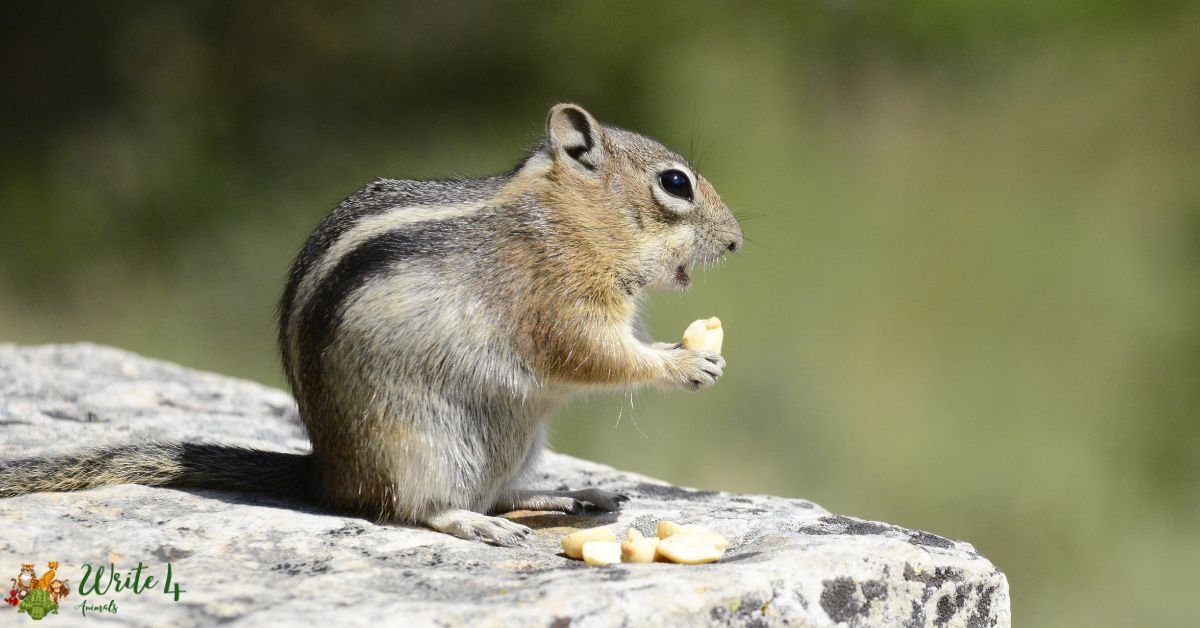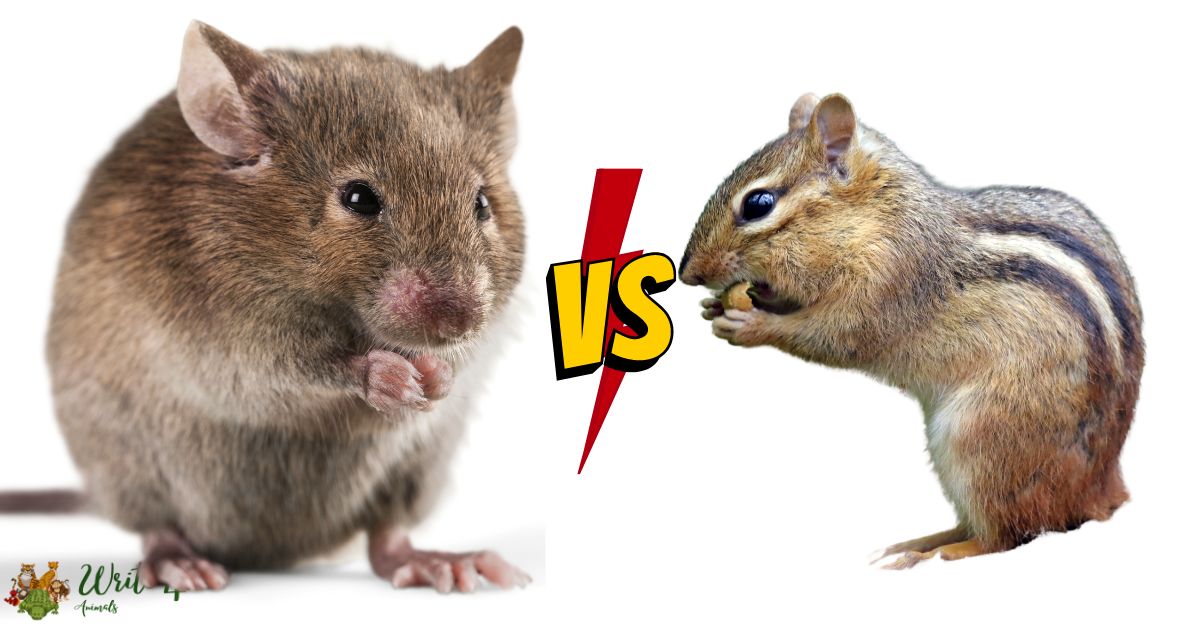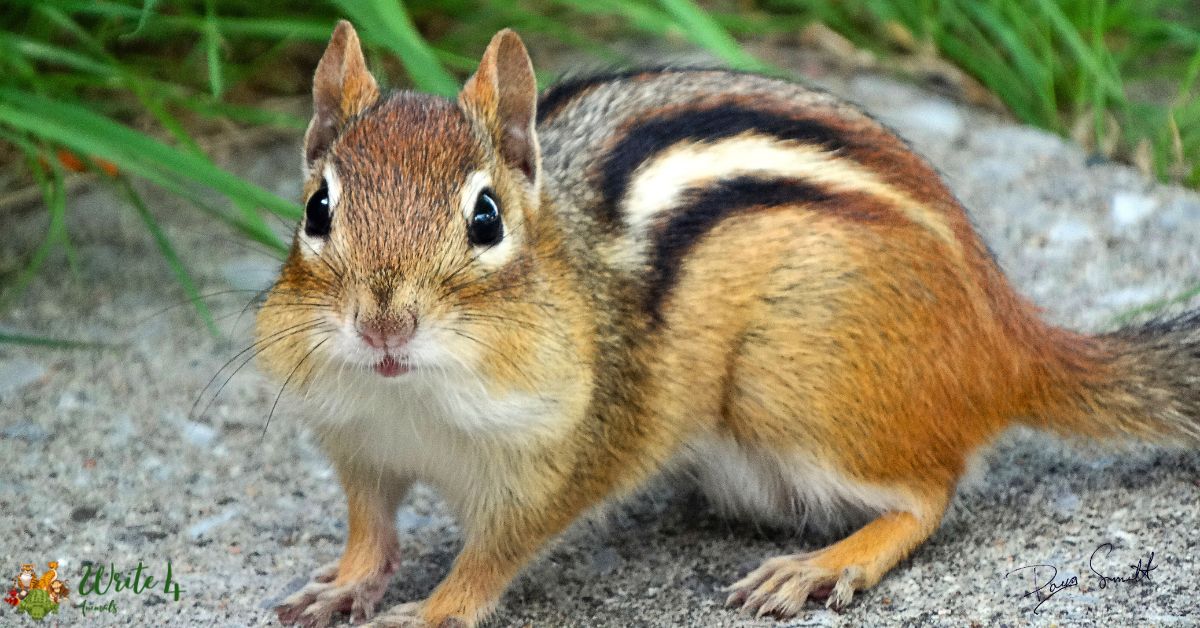When it comes to understanding wildlife, every aspect plays a role in unraveling the mysteries of their behavior and ecology. One such intriguing aspect is chipmunk poop.
While it may seem unusual to focus on their droppings, chipmunk poop can reveal a wealth of information about these charismatic creatures. In this comprehensive guide, we will delve into the complete information about chipmunk poop.
What Does Chipmunk Poop Look Like?
Chipmunk poop, also known as scat, can be easily identified once you know what to look for. The droppings are small and resemble tiny cylindrical pellets.
They have a similar shape to grains of rice or miniature capsules, measuring approximately 0.2 to 0.5 inches in length. The size of chipmunk poop is comparable to a small bead or a raisin.
In terms of color, chipmunk droppings usually range from dark brown to black. However, the exact shade can vary depending on factors such as the chipmunk’s diet and habitat. If a chipmunk has been consuming fruits or berries, you may notice a slightly reddish or purple hue in their scat.
Identifying chipmunk poop can be particularly helpful if you’re trying to determine the presence of these cute critters in your surroundings. By keeping an eye out for their distinctive droppings, you can gain insights into their activities and assess their potential impact on your garden or property.
The Scoop on Chipmunk Poop: Size, Color, and Texture Explained
Chipmunk poop exhibits several characteristics that can provide valuable information about these furry creatures. Understanding the size, color, and texture of chipmunk droppings can help in differentiating them from other similar species and contribute to a better understanding of chipmunk behavior.
In terms of size, chipmunk droppings are relatively small compared to other animals. They are typically around 0.2 to 0.5 inches long, resembling tiny cylindrical pellets. This compact size is a result of their small body size and efficient digestion.
The color of chipmunk droppings generally ranges from dark brown to black. However, variations in diet can influence the coloration of their scat.
If chipmunks have been feasting on fruits, berries, or seeds with vibrant pigments, their droppings may exhibit hints of red, purple, or even greenish hues. This variability in color can be intriguing to observe and can reflect the diversity of their diet.
In terms of texture, chipmunk droppings are usually firm and dry. They are compacted, reflecting the efficient digestion process that chipmunks have developed to extract maximum nutrients from their food. The dry nature of their scat contributes to its longevity and resilience, making it a reliable sign of their presence in an area.
Why Do Chipmunks Poop Everywhere?
Chipmunks have a unique bathroom habit of scattering their droppings throughout their environment. This behavior serves multiple purposes in their daily lives.
Firstly, chipmunks use their droppings as a form of territorial marking. By spreading their scat, they communicate their presence to other chipmunks, establishing boundaries and deterring potential competitors from encroaching on their territory.

Secondly, chipmunks are scatter-hoarders, which means they collect and store food in various locations. As they forage and gather food, they defecate along the way, effectively marking the caches they have hidden.
This behavior helps them remember the locations of their food stores, ensuring they can easily locate them when needed.
Lastly, chipmunks have a rapid metabolism, requiring them to eat frequently. By defecating as they go, chipmunks can maintain a streamlined foraging process without the need to interrupt their search for food by returning to specific areas solely for bathroom purposes. This efficient behavior allows them to maximize their foraging time and energy expenditure.
Is Chipmunk Poop Dangerous?
Chipmunk poop, like the droppings of many small mammals, is generally not considered dangerous to humans. However, it’s important to examine the potential health risks and concerns associated with chipmunk droppings in more detail.
Zoonotic Diseases: While the risk is relatively low, chipmunks can carry zoonotic diseases that can potentially be transmitted to humans. These include diseases such as leptospirosis or salmonellosis.
Direct contact with contaminated droppings or exposure to an environment where chipmunks have defecated may pose a slight risk of infection. It’s important to practice good hygiene and take precautions when handling chipmunk droppings to minimize any potential health risks.
Parasites: Chipmunk droppings may contain internal parasites like roundworms or tapeworms. Direct transmission of these parasites to humans is rare, but it’s advisable to avoid ingesting or inhaling the droppings to minimize the risk.
Allergies: Some individuals may be allergic to the proteins present in chipmunk droppings. Exposure to droppings or the particles they may release into the air can trigger allergic reactions in sensitive individuals.
Symptoms may include sneezing, coughing, itching, or respiratory distress. If you suspect an allergy, it’s best to avoid direct contact with chipmunk droppings and seek medical advice if necessary.
To reduce potential health risks associated with chipmunk droppings, it is recommended to:
1. Wear disposable gloves and a mask when handling droppings or cleaning affected areas.
2. Avoid direct contact with cuts or open wounds to minimize the risk of infection.
3. Properly dispose of droppings and any used cleaning materials in sealed bags.
4. Clean the affected area with a disinfectant cleaner or a mixture of water and bleach.
5. Wash hands thoroughly with soap and warm water after handling droppings or completing the cleanup process.
Cleaning Up Chipmunk Poop: Tips for a Safe and Hygienic Approach
Cleaning up chipmunk poop requires a safe and hygienic approach to minimize any potential health risks. Follow these tips to ensure a proper cleanup:
Wear protective gear: Before handling chipmunk droppings, put on disposable gloves and a mask. This will prevent direct contact with the feces and reduce the risk of any potential pathogens or parasites being transmitted.
Prepare cleaning supplies: Gather the necessary cleaning supplies, including paper towels, disposable wipes, plastic bags, and a disinfectant cleaner. Having these items ready will help make the cleanup process more efficient.
Remove droppings carefully: Using paper towels or disposable wipes, carefully pick up the chipmunk droppings, taking care not to crush or break them. Place the droppings directly into a plastic bag to minimize the spread of any contaminants.
Clean the affected area: After removing the droppings, thoroughly clean the area where they were found. Use a disinfectant cleaner or a mixture of water and bleach to sanitize the surface. Follow the manufacturer’s instructions for proper disinfection.
Dispose of waste properly: Seal the plastic bag containing the droppings and any used cleaning materials securely. Place it in an outdoor trash bin or an appropriate waste disposal container. Avoid composting chipmunk droppings, as they may contain parasites or pathogens that could contaminate the compost.
Wash hands thoroughly: After completing the cleanup, remove your gloves and wash your hands thoroughly with soap and warm water. This will help ensure that any potential pathogens or contaminants are removed from your skin.
Maintain cleanliness: To discourage chipmunks from frequenting the area, clean up any spilled food or potential attractants that may have drawn them in the first place. Keep outdoor areas tidy and free from debris or clutter.
Can Chipmunk Poop Be Used as Fertilizer?
While chipmunk poop is a natural byproduct of their diet and digestion, it is not commonly used as a fertilizer in the same way that animal manure or compost is utilized. This is primarily because chipmunk droppings are small and relatively low in nutrient content compared to other organic sources commonly used for fertilization.
Chipmunk poop consists mainly of undigested plant materials, such as seeds, nuts, and fruits. These materials, when broken down naturally, can contribute to the nutrient cycle in ecosystems. However, the quantity and nutritional value of chipmunk droppings are not significant enough to be used as a standalone fertilizer for plants.
For effective fertilization, it is generally recommended to use compost or well-decomposed organic matter that provides a more balanced range of nutrients for plants. Composting a variety of organic materials, including kitchen scraps, yard waste, and other suitable materials, creates a nutrient-rich compost that can be used as a soil amendment.
Chipmunk poop vs Mouse poop
When it comes to comparing chipmunk poop and mouse poop, there are several noticeable differences that can help distinguish between the two. Here’s a comparison of their characteristics:

Size and Shape
Chipmunk Poop: Chipmunk droppings are relatively small, measuring around 0.2 to 0.5 inches in length. They are cylindrical in shape, resembling tiny capsules or grains of rice.
Mouse Poop: Mouse droppings are slightly larger than chipmunk droppings, typically ranging from 0.1 to 0.4 inches in length. They are elongated and have a more cylindrical or spindle-like shape.
Color
Chipmunk Poop: Chipmunk droppings generally have a dark brown to black coloration. However, the exact shade can vary depending on the chipmunk’s diet, with hints of red or purple if they have consumed fruits or berries with pigmented seeds.
Mouse Poop: Mouse droppings are usually black in color, but they can also appear dark brown or grayish-black, depending on the mouse species.
Texture
Chipmunk Poop: Chipmunk droppings have a firm and dry texture. They are compacted and solid, reflecting the efficient digestion process of chipmunks.
Mouse Poop: Mouse droppings have a softer texture compared to chipmunk droppings. They are often described as moist or slightly mushy.
Quantity and Location
Chipmunk Poop: Chipmunks scatter their droppings randomly throughout their environment as they forage and move around their territory. They do not have specific areas designated for bathroom use.
Mouse Poop: Mice tend to deposit their droppings in concentrated areas, usually near their nests or along their regular paths. Mouse poop can be found in corners, along walls, or in hidden areas where they nest.
Chipmunk Poop vs Squirrel Poop comparison
When comparing chipmunk poop and squirrel poop, there are some distinct differences that can help differentiate between the two. Let’s explore the characteristics of each:
Size and Shape
Chipmunk Poop: Chipmunk droppings are small in size, typically measuring around 0.2 to 0.5 inches in length. They have a cylindrical shape, resembling miniature capsules or grains of rice.
Squirrel Poop: Squirrel droppings are relatively larger than chipmunk droppings. They are elongated and oblong, ranging from 0.4 to 0.8 inches in length. Squirrel poop can be described as pill-shaped or oval.
Color
Chipmunk Poop: Chipmunk droppings generally have a dark brown to black coloration. The exact shade may vary depending on the chipmunk’s diet, with potential hues of red or purple if they have consumed pigmented food items.
Squirrel Poop: Squirrel droppings usually have a dark brown color, but it can also appear slightly lighter or grayish, depending on the squirrel species.
Texture
Chipmunk Poop: Chipmunk droppings have a firm and dry texture. They are compacted, reflecting the efficient digestion process of chipmunks.
Squirrel Poop: Squirrel droppings have a softer texture compared to chipmunk droppings. They are often described as moist or slightly mushy.
Quantity and Location
Chipmunk Poop: Chipmunks scatter their droppings randomly throughout their environment as they forage and move around their territory. They do not have specific areas designated for bathroom use.
Squirrel Poop: Squirrels tend to deposit their droppings in concentrated areas such as near their nests or in specific spots they use as latrines. These latrine sites can contain larger amounts of squirrel poop.
How to Prevent Chipmunks from Leaving Droppings in Your Yard
If you want to prevent chipmunks from leaving droppings in your yard, here are some effective strategies:
Remove Food Sources: Chipmunks are attracted to areas with readily available food sources. Ensure that bird feeders are positioned in a way that discourages chipmunks from accessing them. Clean up fallen birdseed regularly and consider using squirrel-proof feeders.
Secure Trash and Compost: Chipmunks are opportunistic foragers and may be attracted to uncovered trash or compost bins. Use tightly sealed trash cans and secure compost bins to minimize their access to potential food sources.
Seal Entry Points: Inspect your property for any gaps or openings that chipmunks can use to enter. Seal off gaps in foundation walls, repair damaged screens on windows and vents, and ensure that doors and windows are properly fitted.
Trim Vegetation: Trim tree branches and shrubs that may provide easy access to your property. Maintain a clear space between vegetation and structures to make it more challenging for chipmunks to reach your yard.
Install Barriers: Use wire mesh or hardware cloth to create physical barriers around vulnerable areas. For example, you can place it around the base of plants, gardens, or areas where chipmunks tend to frequent.
Natural Repellents: Consider using natural repellents that deter chipmunks. Some options include the scent of predator urine, such as that of foxes or coyotes, or repellents containing ingredients like garlic or capsaicin. Follow the instructions on the repellent product carefully.
Live Trapping and Relocation: As a last resort, you can use live traps to catch chipmunks and relocate them to a more suitable habitat. Ensure that you check local regulations and follow ethical guidelines for trapping and relocation.
Frequently Asked Questions
[sc_fs_multi_faq headline-0=”h4″ question-0=”How often do chipmunks defecate?” answer-0=”Chipmunks defecate regularly as they forage and move about their territory. Their frequent feeding habits result in regular droppings.” image-0=”” headline-1=”h4″ question-1=”Can I compost chipmunk droppings?” answer-1=”It is generally not recommended to compost chipmunk droppings. While they can break down naturally, it’s best to avoid composting them due to the potential presence of parasites or pathogens.” image-1=”” headline-2=”h4″ question-2=”How long does chipmunk poop take to decompose?” answer-2=”Chipmunk droppings can decompose relatively quickly, usually within a few months, depending on environmental conditions and the presence of decomposers.” image-2=”” headline-3=”h4″ question-3=”Are chipmunk droppings a sign of an infestation?” answer-3=”Chipmunk droppings alone may not necessarily indicate an infestation. However, an abundance of droppings in a concentrated area could be a sign of a high chipmunk population or their frequent presence.” image-3=”” headline-4=”h4″ question-4=”Can chipmunks transmit diseases through their droppings?” answer-4=”While the risk is generally low, chipmunk droppings can potentially carry zoonotic diseases. It is advisable to take precautions when handling them, such as wearing gloves and washing hands thoroughly.” image-4=”” headline-5=”h4″ question-5=”Do chipmunks eat their own droppings?” answer-5=”Chipmunks, like many rodents, practice coprophagy, which is the consumption of their own droppings. This behavior allows them to obtain additional nutrients and aids in digestion.” image-5=”” headline-6=”h4″ question-6=”How long do chipmunk droppings remain visible?” answer-6=”Chipmunk droppings can remain visible for varying periods depending on weather conditions and their exposure to elements. However, they are relatively resilient and can persist for several weeks or even months. ” image-6=”” headline-7=”h4″ question-7=”Can chipmunk droppings attract other pests?” answer-7=”Chipmunk droppings alone are unlikely to attract other pests. However, if the droppings are accompanied by food sources or if the area is not properly cleaned, it could potentially attract other animals like insects or scavengers.” image-7=”” count=”8″ html=”true” css_class=””]
Recommended
1. 21 Types of Lizards in Mexico (With Pictures) 2023
2. 12 Biggest Cat Breed in the World
